
(Photo sent in by a reader)
Every time we turn around we hear another city staffer or elected official tell us how serious they are about cycling. They say it’s key to our health outcomes, it’s the only way we’ll reach our climate change goals, it buoys our national reputation, and so on and so forth.
But if we’re really serious about cycling, why don’t we take our cycling infrastructure seriously?
There are too many examples in Portland where the design and implementation of our cycling infrastructure has not been completed with the care and seriousness it deserves.
Here are a few of those examples:
Northeast Couch at the Burnside Bridge
The City of Portland’s Bureau of Transportation has known for years that the design of Northeast Couch as it approaches the Burnside Bridge is dangerous. The problem is that people in cars cut the s-curve and drive in the bike lane. Their latest attempt to fix the problem was to glue “rumble bars” to the pavement in hopes that the jarring noise would alert clueless vehicle operators. That attempt failed miserably. Today only a few of the bars remain and the rest are scattered all over the street.
Southwest 13th at Clay
In another attempt to protect bicycle riders from dangerous driving behaviors, in January PBOT installed plastic wands to separate the bike lane on Southwest 13th as it approaches Clay. Within a few hours of installation a wand had been ripped out by a careless driver. As of today just one wand remains.
Northwest Lovejoy ramp toward 9th
In December 2011 PBOT installed plastic wands to help separate the downhill bike lane on NW Lovejoy (westbound on the ramp toward 9th) from the adjacent lane. After streetcar tracks went in, many people in cars drove in the bike lane to avoid driving on them. Just four days later, many of the wands had been ripped up by people who lacked the skill and/or respect to maintain their lane of travel. One month later they were re-installed. Then a few days later they were ripped up once again.
PBOT ultimately gave up and has never even attempted to replace this safe cycling infrastructure.
Advertisement
Northeast Multnomah
The bikeway on Northeast Multnomah is often held up as PBOT’s best “protected” bike lane in the entire city. Unfortunately it’s become so tattered and unkempt since it debuted in 2012 that it’s merely a shell of its former self. Much of the bold “beeswax” paint is gone, all the plastic wands have long been ripped out and never replaced, and even the massive concrete planter boxes have been hit and damaged and moved around. This lack of maintenance is even more troublesome because it’s been almost two years since the project’s task force agreed to make this bikeway permanent.
Northeast Rodney at Ivy
In order to preserve a low-stress cycling environment on Northeast Rodney (a key parallel bikeway that complements North Williams Avenue), PBOT decided to put a traffic diverter at Ivy. That diverter was installed 17 months ago. Just a month after it went in, the design was so meager that many people simply ignored it and drove right through it. Today PBOT still hasn’t done anything to improve the design. Most of the plastic wands are on the ground and people are dumping trash around it. In the words of a reader who lives in the area, “It’s a big, gross mess.”
It’s very important that we get this right.
There are real safety risks to consider. Because nearly all cycling infrastructure in Portland is still created with only paint and plastic, it stops working when either one of those things goes away. In every example above, the dangerous behaviors PBOT tried to stop have started up again.
But beyond a lack of effectiveness, there’s something equally troubling. This lack of seriousness is a signal to all Portlanders about our priorities. When bike infrastructure is allowed to decay it tells everyone we’re not willing to invest the time and care it takes to make it work and we ultimately don’t care about the people who use it.
I know we can do a better job at this. Let’s do it. Seriously.
— Jonathan Maus, (503) 706-8804 – jonathan@bikeportland.org
BikePortland can’t survive without paid subscribers. Please sign up today.


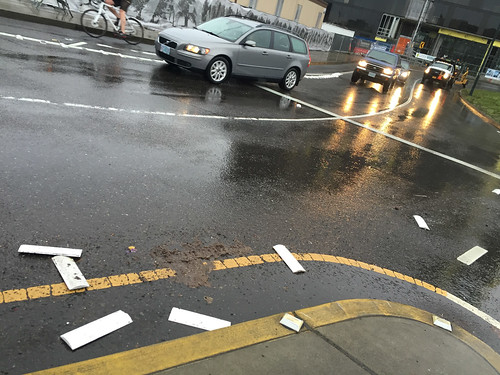
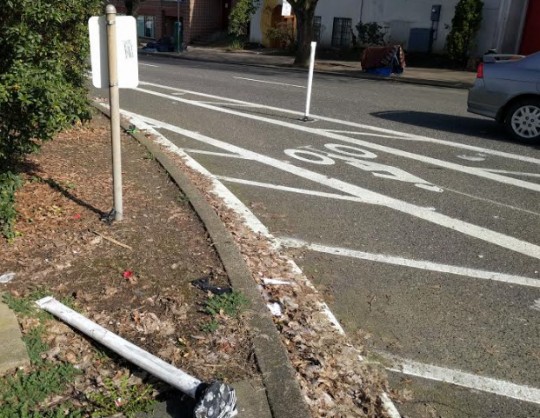
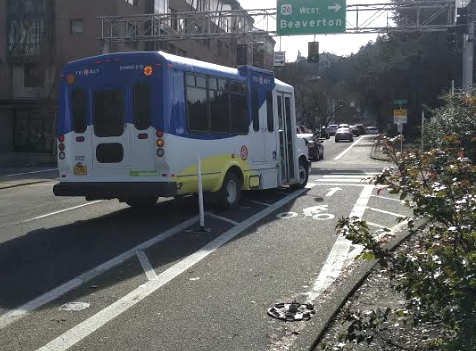
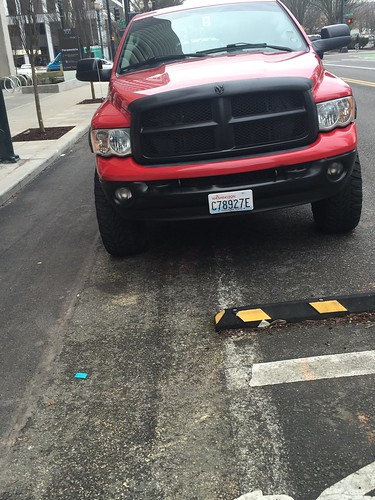
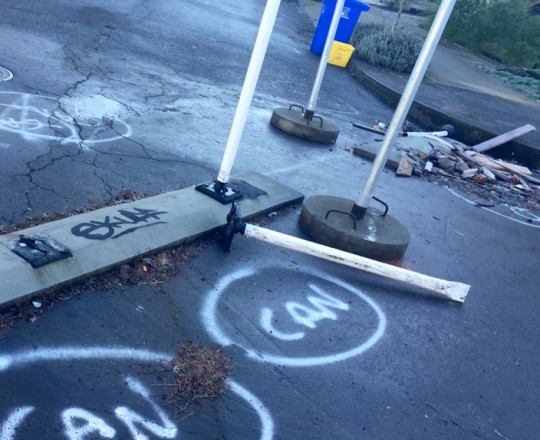

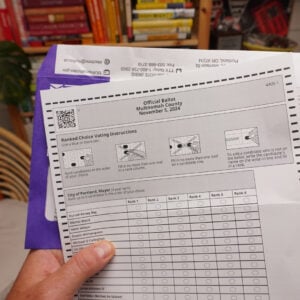
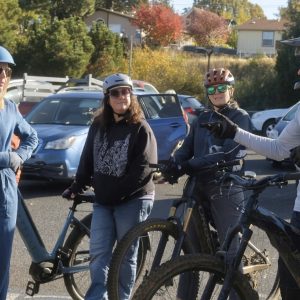

Thanks for reading.
BikePortland has served this community with independent community journalism since 2005. We rely on subscriptions from readers like you to survive. Your financial support is vital in keeping this valuable resource alive and well.
Please subscribe today to strengthen and expand our work.
The Rodney diverter: it is a hot mess right now, but I thought that was because of the partial digging up of the street going on between Fremont and Ivy right now. I also can’t tell if the diverter is closed to bikes or not: the “except bicycles” on the signs are crossed out, and there is a road closed sign, but they haven’t blocked the bike cut-outs so it’s easy to roll through. It’s really confusing and yet another example of poor construction detour planning.
I’m pretty sure those “can” markings on the pavement indicate where barrel-style diverters will be installed. Remember that the Rodney greenway is not finished yet! The contractor still needs to replace the diverter and put in the crossing at Fremont. Contractors get a lot of leeway as far as timing, especially given the rainy season.
Beeblebrox,
I’m aware that it’s a temporary marking. But it’s been 17 months. And why is almost every bike-related project “temporary” to begin with? Because politics that’s why.
Why don’t we take cycling seriously enough to stop the political games and just do things right the first time.
Our current modus operandi jeopardizes not only our council-adopted climate, transportation, and planning goals it also puts people’s lives at risk.
I’ve been bothered with “temporary” and “experimental” labels. Sure, it’s great to show what can be done, but the outcome is basically paint? Better Block and all the other orgs are spending a lot of time and money, then the city half-asses it.
I don’t have anything against using those labels, but PBOT must follow through and actually improve the facility in a timely fashion.
NYC is the model for this. They re-allocated space to bikeways and plazas any way possible… even put lawn chairs out on Times Square at first! But the key is they went back in due time and replaced the temporary/experimental with world-class quality design.
this used to be cones and paint too:

Right, I just think it’s a waste of time if it doesn’t lead any farther than paint.
Here in Greensboro, Portland is only known (and revered) for its successes, its fantastic bike facilities and usage. I’m sure NYC has lots of failures similar to what you are editorializing about, but neither of us live there, and chances are we’ll never discover those failures. But I’m certain somebody living there is bitching about them, and how Portland does everything right. It certainly is green there, isn’t it, on the other side of the fence?
Not sure why it matters whether NYC has failures or not. Of course they do! Just because I highlight some things they do well doesn’t mean I think they’re the be-all/end-all of cycling infrastructure perfection.
And people in other places are welcome to continue to believe the false narrative about Portland being a bike utopia. I know it’s not. I also know that there are a lot of people (even “bike people”) in this town whose identity, lifestyle and/or pocketbook are directly tied to maintaining that narrative. Mine is not. My business relies on Portland being the best cycling city in the world. It’s our job to cut through the bullshit and be honest with people about where we stand. I believe that anything we do to perpetuate the false narrative that we’re already the best makes it harder for us to do the actual work it takes to get there. It’s called complacency right? This town lacks a sense of urgency to be great. We’re good… But we could – and should be – great. I’m just trying to do my part to get us there. I appreciate your feedback. If my tactics are wrong, I want to hear about it.
Jonathan, the work that you and Michael do with the blog is highly valuable, and your tactics are usually spot-on, maybe even in this case. My concern, as a bike advocate, is that you are complaining, even whining, a bit like the PBA often does. Yeah, sometimes what PBOT projects do look like crap, but it often really is a maintenance issue, and sometimes it’s a cut-rate construction issue (as others have rightly pointed out.) But what, exactly, are you going to do about it? Complain more? Sorry, but I used to be like that, but now I try my best to fix it, or else live with it, and fight some other battle worth fighting.
David, I don’t think that’s fair. There’s a lot being done in the community, most of it at least tangentially involves BikePortland, and BP has been a driver of things like Wonk Night and educating us about advocacy efforts we may not all know about.
If nothing else, Maus hauls free beer and snacks around for us.
NYC flexiposts seem to handle abuse well: https://www.youtube.com/watch?v=BWszKNEsBqE#t=760
What is “Right”?
Could you get five people here to agree on the right way to deal with bike traffic on a road?
Hell, I don’t know. I’m still trying to figure out why you need bike lanes on a 25-25mph road in the first place. I’m not sure I’ve ever seen a 25mph road until I moved here. Spend my life riding on 45-55mph roads and it didn’t take long to learn that the further left I moved the more space I was given.
People here seem to think the exact opposite. You keep calling for infrastructure, but can’t point to a single ideal implementation. Meanwhile, the transportation guys are just f’in around with play money. Test this, test that.
Anyway. In parting… you don’t get right hooked by the car that’s directly behind you.
That strategy is the quickest way to <1% bike mode share that I can think of.
Protected cycleways are the ideal implementation.
well, but they are not. the typical protected bikeway presents a significant obstacle to a vehicular cyclist who wants to set up a left turn. and it offers right hooks at almost every intersection.
A well-designed protected cycleway prevents right-hooks via use of protected intersections. As for the vehicular cyclists, they can ride wherever they want anyway, so why should we let them hold back true 8-80 cycling infra?
while 814.420 is on the books it is not strictly true you can ride wherever you wanna if there is a dedicated bike facility over there. also of course the psychology of the situation. get off the road much easier to say if there is a bike lane over there. when i lived in portland i did exactly as you suggest, but it imposes a psychological burden. which don’t get me wrong i am strong enough to shoulder, but it is wearing.
But the cycleway IS part of the road. As is the sidewalk. And while I agree that law needs to go away, it’s not as if its’s actually enforced in Portland.
Vehicular cycling is an extreme sport enjoyed by a small minority of people. We don’t design buildings for BASE jumpers, and we shouldn’t design roads for cyclists who want to ride in traffic.
nor should we design bike infra to in effect force novices into inherently dangerous situations. and of course as a vehicular cyclist i will disagree with your premise. knowing how to handle myself on roadways is what has kept me safe for twenty years. it is not a sport, and it is not extreme.
I’ve thought the reason they are “temporary” is so many of these are experimental and not per the MUTCD. I agree though that proper followup is warranted.
I think the contractor should save money by using some of the 3 foot tall Jersey barriers they pulled off some of the freeways. ODOT found they were too short and put in 4 foot tall barriers. Cars wont drive over them.
In fact they would work i all the places that armored personnel vehicles are wiping out poles and rumble strips. Like Couch!
The detour because of the current sewer construction reroutes cyclists to ride on MLK! It’s only for 2 blocks, but that is still an unacceptable detour for every cyclist, especially considering there aren’t “Bicycles on Roadway” signs on MLK.
So, they need signs to tell them that bikes might be on a road?
We’re legal vehicles, not Caribou. What’s the purpose?
the purpose would be to increase awareness. but i suppose you knew that.
We need actual infrastructure, not paint and epoxied wands. People generally respect curbs.
bike lanes in seattle, SF, DC, and chicago are protected by flexible delineators. the delineators on the hawthorne bridge have been maintained. we should not throw out useful tools due to PBOT’s cheap/poor implementations.
Anyone else ever wonder when it was decided that delineators had to be flexible? And by whom?
they don’t have to be as michael shows here:
http://www.peopleforbikes.org/blog/entry/14-ways-to-make-bike-lanes-better-the-infographic
Maintained, meaning replaced when someone drives through them.
Remember the whole “maintenance” versus “safety” debate with the various PBOT street fees? Sounds like you agree with PBA, that maintenance should be the highest priority. Never mind that you have diverters, protected lanes, gores, and candlesticks to complain about (unlike the community I now live in), now you have to bitch like a downtown developer that they are not being maintained properly. Meanwhile, folks in SW and East Portland go without.
Shame on you.
TLDR: “you should be happy with what you get”
Hi David! Nice to hear from you.
I have a good record of saying we should not allow ourselves to get into the false “safety vs. maintenance” dichotomy. I absolutely agree that we need maintenance… I just disagree that maintenance has to exclude any upgrades/upkeep for cycling.
And just to clarify… My point in this article isn’t to bemoan the lack of maintenance.. It’s more about trying to make the point that PBOT needs to be more serious and professional about how they implement bikeway access projects. As the examples in this article point out, they’re not doing their best work with this stuff and it shows.
Jonathan, I understand your intent of this editorial piece, but your examples show failures on the part of PBOT, as a holistic organization. However, it’s been my experience that PBOT operates (still) as three or more separate bureaus, as they did in 2000 when I first worked for them. For example, the traffic safety and active transportation folks, including all the planners like Roger, Greg, April, & Art, are very bike-oriented. They mean well and they do their very best in design. But they do not actually build anything, let alone maintain stuff. Instead, they forward their plans to the engineers (civil design usually), who make decisions about what exactly gets built, when, and how quickly. Some of those engineers bike, walk, or use transit regularly, some don’t. The engineers then forward funded projects to either the maintenance folks to build (if it is under $125,000) or to outside contractors to bid upon. Some of the maintenance folks use active transportation, but most don’t. They are also the lowest paid employees at PBOT. The outside contractors are almost universally car drivers. When they build a bike project, it’s just a job. And then there is no funding for maintenance afterwards (there is a $900+ million backlog rising by $60 million every year.)
My point here is that at each remove, PBOT becomes less bike-oriented, and more reflective of the overall culture of Portland, were over 70% of all users still use a car for nearly all their transportation. In northern Europe, you actually see the low-paid construction laborers biking to work, so they naturally take pride in building bike infrastructure that lasts. Our laborers, not being paid enough to afford to live in bikable inner Portland, often have drive to work, to the BOM facility on Russell, from their homes in Vancouver, East Portland, Gladstone, or Tigard. So until inner Portland becomes affordable again, you will continue to see great progressive ideas come from PBOT designers, but poor follow-through on the part of the rest of the huge 750-employee bureau.
It sounds like removing all the car parking from any area/building that houses city staff would go a long way towards better design, construction and maintenance as more and more city staff have skin in the game.
Because we want to pay city employees for the extra hours and manpower required to haul construction and maintenance equipment around on bicycles? I think we’d see a lot less work done on the streets, not more.
That’s absurd. The vast majority of city employees are at desks, not “haul[ing] construction and maintenance equipment”.
So do you want to prohibit city employees from driving their personal cars to/from work? What exactly are you/Adam proposing?
I interpreted this article as pointing toward entirely different infrastructure rather than increased maintenance.
My main takeaway from this is that wands only really help when the lanes and bikeway are straight. They don’t work very well when turning movements are involved, especially when they’re not designed for actual turning radius needs. In some of these cases, like at 13th/Clay, I honestly think a mixing zone (shared through bike and car right-turn lane) would be better.
There’s a simple answer to that question. The city leadership is not serious about cycling. It’s mostly all talk. They want all the recognition but won’t do any of the hard work or take a politically-unpopular stance for the greater good of the city. Instead we go after low-hanging fruit and relatively politically-easy projects. Time and time again, the city presents something as a bike project yet makes very few concessions to drivers.
Retaining parking is still at the top of the transportation pyramid and the basis for why we can’t install true protected cycleways. Minimum parking requirements for developments are instated based on complaints by a few neighbors, even though this is against their best interests, since more parking means more traffic congestion. Businesses are able to singlehandedly kill a bike facility for concerns about parking, and the city leadership lacks the will to stand up for them. Hopefully the upcoming parking management plan will address these issues.
Every plan is judged based on how it impacts drivers. This is a backwards approach. We need to recognize that designing cities for universal car ownership has destroyed communities and taken countless lives. Motor vehicles are the sole barrier to safe streets. We need to design from the bottom up, taking this fact into account, i.e. “how will this project improve safety for people walking and cycling by limiting misuse of motor vehicles?”
We as a city are great at planning but fall short on the execution. We need to be better at acting in the interests of our own stated goals and plans. There are a lot of good people working for the city in various bureaus, trying hard to implement these plans, but are continuously shut down by the lack of vision by our elected officials. There have been some victories on this front as of late (Tilikum Crossing, bike share, etc.) and plenty of reason to be hopeful that things will change soon, so it’s time for city leadership to take advantage of that momentum.
Steps 1, 2, and 3 are strict enforcement of traffic laws in the morning, day, and night. Tolerating lawlessness from drivers is going to cause problems for any infrastructure.
It would indeed help if we had some leaders that lead from the front. I would like to vote “no” for city council.
This is a great point, Eric. To paraphrase a lawyer friend, we don’t need another law, we need to enforce the ones we already have.
I think it is much more efficient to use road design to influence driving patterns, than to double the size of the traffic division of the PPD.
If turning cars encroach into a bike lane, then use rumble strips, curbs, delineators, to discourage that. IF, that is, the negatives don’t outweigh the positives. Sometimes it is useful for cyclists to be able to freely move in and out of the bike lane.
We definitely need better enforcement of our current traffic laws. But what would be better is to install self-enforcing infrastructure. Why rely on enforcement for people parking in bike lanes when you can just install a curb to prevent this? Instead of relying on speed limit signs and cops to pull over speeders, narrow the roadway to motorists are forced to slow down. Instead of issuing tickets to every driver that runs a particular stop sign, make the entire crossing a raised speed bump so they slow down on their own. Well-designed infra works regardless of PPB’s current budget or staffing problems.
Raised intersections ($20K) don’t slow down cars. The longer the bump, the less the effect.
And we can’t have 8ft lanes because the bus would have to drive the posted speed and wouldn’t be able to make its schedule.
The bus itself is 8 feet wide, as permitted by law, and the mirrors extend out beyond that. This does not preclude narrow lanes on local streets.
Also, PBOT has a skinny street standard, as well as a narrow shared road standard. PBOT is also investigating how to better use existing law to use available lower statutory speed limits.
Depends where we are talking. In outer east Portland, raised intersections would have a huge effect. Downtown, average speeds would be about the same.
Actually, when speed bumps were being tested in the mid to late 1990’s, Beaverton tested a speed table with a 20 or 30 foot flat section. The idea being to use them on 35 mph streets. So, if the average local or collector street is about 36 feet wide, and you want the raised area to also encompass the crosswalks, you end up with a speed table that has a flat section about 46 to 50 feet wide. At the approved standard height of 3 inches, I’d guess 85th percentile speeds over the raised crossing of 30-35 mph. That is not much 85th percentile speed reduction, even in east county.
I suppose that depends on how sharp of an angle the bump-up is at. If it’s too shallow, the bump won’t be effective.
if it’s too steep it causes damage/liability. The subtle aspects of road design are not that simple.
The driver can’t just slow down to avoid damage? This is indicative of our highly litigious culture that a road engineer can’t design something safer because they might get sued by a driver who drove too fast and broke their car.
I’ve live where traffic laws are vigorously enforced. It simply works. You don’t need any infrastructure when the motorists all obey the law.
I’ve lived in the exact same place after the build-out of extensive segregated infrastructure and no traffic law enforcement. It doesn’t work nearly as well. There’s only a small fraction of the bike modal share that the zero-tolerance traffic law enforcement caused.
I acknowledge that it may be theoretically possible to get high modal shares without vigorous traffic law enforcement, but I know of no location in the world that has done it. Traffic law enforcement should be the issue on which all cyclists and advocates agree and push together. I fear we will not have much success until many, many more cyclists agree with me. It’s not sexy and it doesn’t make great press releases, but it does get butts onto saddles.
Can you give examples of which cities these are?
Guest article please?
I don’t disagree with a lot of what you’ve said here, but I would challenge you to think about whether this is, at its root, really a political problem, or a cultural one. In my view, we have created a society which values personal freedom above all else, and, due in part to nearly a century of marketing, the car is a primary symbol of that freedom.
How do we go about changing the culture? How do we combat the deep pockets of car manufacturers? How do we implement culturally unpopular policies through politics while retaining the power to continue with that influence in the future?
I believe it to be both. We have a serious car culture problem in the US, but the politicians could be doing far more to stand up to it. Especially at the local levels.
” the design was so meager that many people simply ignored it and drove right through it.”
This really sums it all up perfectly.
I feel like so much design here is done around the notion of “what we want people to do” rather than asking the question “What would annoyed people do with this design?”
Don’t forget the Cully cycle/debris/garbage/parking track. It’s pretty much unattended.
Have you requested maintenance? 823-1700 or 823-SAFE?
No offence, but that hotline is a joke. Last I heard, there was a six week backlog of requests from 823-SAFE. Many of my and others’ requests get ignored completely. If PBOT must rely on a user hotline to fix their problems, the least they can do is put more staff towards completing requests.
Offence is never given, only taken. None taken. To address your Portland urban myth:
The backlog for an investigation of a change to the current system is 16 weeks. This is stuff like relocate a sign, add a crosswalk, change a speed zone, build a ramp.
Maintenance requests – signs down, lights out, signals flashing, graffiti, are put on the next day’s/week’s work schedule.
the direct line to maintenance dispatch is 823-1700, and it is manned 24/7.
Thank you. That’s not actually as bad as I feared. Still, it would be nice for PBOT to take a proactive approach, using the hotline only as supplemental, rather than the primary driver of maintenance. Hoping the gas tax can help alleviate this.
The city just repaved Burnside east of 82nd and is about to re-stripe a 2ft wide door-zone bike lane at Burnside and 87th because they aren’t willing to eliminate 5 barely-utilized street parking spots in a neighborhood full of houses with driveways/garages and no commercial businesses. This is not progress.
I just sent a safety concern in using the new form. Maybe we’ll get lucky and they will decide to remove the north side parking and increase the width of the bike lanes before the permanent lane markings go down. I give it about a 2% chance of happening. You know, got to keep that car parking.
As stated in a earlier story referencing the same thing on N Skidmore, PBOT does not remove parking without a public process. If you want stuff changed without a public process, be careful what you wish for. The next time around it might be something you like that gets removed.
This is part of the problem, though. The public process as currently executed invites too much opportunities to kill or seriously water down projects based on what people “like”. It’s government’s job to weigh what people want against what they need – which are not always perfectly aligned – and make a decision that is good for the city’s future. Too often we react to what people want, rather than what they need.
We agree on the role of government. However, rational people can disagree on the difference between ‘need’ and ‘want’, and context is important.
That’s a 4-foot bike lane, not a 2-foot bike lane. Exaggeration isn’t very helpful.
Chris, are you sure you’re not mistaking the bike lane buffer (which is 2′) for the bike lane itself? I know because I’ve seen the design, and there are no 2′ bike lanes.
I’m pretty sure that’s the case. As far as I know, we’re getting buffered bike lanes on that stretch of Burnside that’s being repaved.
yeah, the wider part is too narrow for parking, so it must be a buffered bike lane. (rode it today)
Steve Novick is the Transportation Commissioner, right, and he’s up for re-election. Somebody get a statement from him….
Hire an experienced designer from Holland or Denmark.
to get an engineer from the netherlands or portland to accept this job portland would have to agree to tens of millions in new taxes to pay for bike infrastructure.
we get the infrastructure we pay for: facilities built on a shoestring without sufficient funding for maintenance. i support a gas tax, even though it is a regressive tax, only because our lack of infrastructure funding is at crisis levels.
portland = denmark
I wish. 😉
percentage of bike commuters:
portland = 7% (at it’s height, right?)
copenhagen = 70%
i was correcting my comment above, not making an equivalency.
Some of these locations, e.g. SE 9th/Clay, could use a curb “island” with a sign. Cars won’t commonly drive over those.
Frickin’ jersey barriers and we’re done…amazing to me that we even have to think about this.
one thought:
did you consider the rear wheels of turning trucks with trailers? tracking?
there are two sides to every wall. the cyclist is protected from encroachment, but cannot move out of the bike lane.
The Northeast Multnomah example is, in my mind, the most telling (and most depressing). PBOT loudly heralded the success of the work there, and its current condition is a mess. Which means Portland’s self-professed best example of protected bike lanes is “we did some interesting work, then failed to extend it or even maintain it”.
Portland’s cycling infrastructure, at this point, seems more like a collection of different eras of experiments than a cohesive network.
And with Amanda Fritz advocating that cars cut off main routes and take quieter side streets whenever traffic backs up, we really are not going to get any better….
That facility was funded by the Lloyd Transportation Management Association, not PBOT. Outside of federal grants, PBOT has peanuts to spend on bike infrastructure and bike infrastructure maintenance. PBOT is not perfect* but it has the hopeless task of trying to make infrastructure improvements with a joke of a budget.
*For example, their institutional cowardice when it comes to parking removal and diversion by default.
Interesting – thank you for clarifying. Do you think PBOT’s lack of involvement in original funding is why this particular stretch has fallen into disrepair?
I think PBOT lacks the funding it needs to maintain infrastructure full stop.
Call this the Broken Windows theory of PBOT: the citizens of Portland take so little pride for themselves, I don’t know why they expect PBOT to do better with the streets.
Prune your landscaping so people don’t have to bushwhack as they walk by your home. Keep your sidewalk in good repair and clear of fallen fruit, other debris, and ice. The street is not for long-term storage of ANYTHING, especially loose leaves, topsoil, gravel, or broken automobiles.
Just a thought.
All diverters should be erected similar to the setup at N Central and N Tyler street: Big, decorative, staggered, concrete planter boxes that in no way is a car driving through.
Simply gluing polls or rumble strips to the ground is egregiously-lazy thinking and PBOT should be ashamed.
BTW, those have had to be repositioned once.
Due to funding constraints, we are a complaint driven agency. Please call 823-1700 or use PDX reporter app to help us maintain our system!
Thank you for your response! I hear there is a six week backlog of requests from the hotline. How are these issues prioritized? When can we expect PBOT to move to a more proactive system?
Leah, Thanks for wading into the BP comments.
This was the response to a recent complaint from a BikeLoudPDX member:
Can you provide any context for the service request? As frequently stated, the type of request affects the quickness of the response. It’s called triage.
Yes, they do seem to respond quickly to broken stuff, except speeding enforcement requests, which will ultimately be answered with “only 11+mph over the posted speed will ever be enforced, and there’s not enough manpower for even that.” Nevermind crosswalks, bike lanes, stop signs, and turn signals.
Of course, speed enforcement isn’t PBOT’s job. Why have we allowed PPB to punt these complaints onto PBOT’s hotline?
Crosswalk enforcement actions are good, but we need it every day and without the advance warnings. How much of that is coming from PBOT’s budget and why?
PBOT gets the calls anyway, and has a system to track the requests, so acts as the intake point for PPB enforcement requests. PBOT working with PPB is a beneficial thing, since, for road safety, both agencies have the same ultimate goal – more safety.
Enforcement actions are a PBOT program.
Broken bicycle sensor at 16th and Hawthorne.
There is also this online form: https://www.portlandoregon.gov/transportation/article/564769
I am guessing Austin riders are happy the city did something and put in protected lanes instead of doing nothing…and listending to those who espouse that said protected lanes are more dangerous.
The city puts up some bike infra knowing that dome purists will lambaste them for not doing enough or making it somehow more dangerous.
I would hate to be the bike coordinator in Portland under those conditions.
Did we? Some places yes, some places no. 🙂